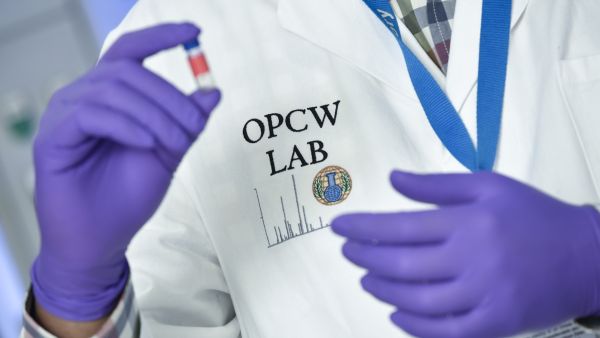The Assad regime dropped barrel bombs containing chlorine gas on an opposition-held area of Syria in October 2016, the world’s chemical weapons watchdog concluded in a report on Tuesday.
Inspectors from the Organization for the Prohibition of Chemical Weapons obtained an industrial chlorine cylinder retrieved from the site near a field hospital outside the town of Kafr Zeita and were able to “positively link” it to the attack, helped by digital evidence and witness interviews.
The @OPCW's new report examines a 2016 attack on Kafr Zayta in #Syria, & confirms the use of chlorine.
— GPPi (@GPPi) February 1, 2022
It is an early example of what would become the most common chemical munition used by the Syrian regime: a chlorine barrel bomb.
More in our typology: https://t.co/cHbAwN8iFN https://t.co/WIXvZuEACp pic.twitter.com/BicRu93aMk
“The report concluded there are reasonable grounds to believe that the industrial chlorine cylinder was used as a weapon,” the watchdog said.
Witnesses at the time reported a helicopter taking off from regime-held Hama airport before the attack on an agricultural area where a number of opposition groups were sheltering in caves.
“Shortly afterwards, the helicopter dropped two barrels, according to a number of witnesses, while others reported being aware of one barrel only,” the report said. “Approximately 20 individuals suffered from suffocation and breathing difficulties.”
#OPCW formally concludes chlorine used in October 2016 airstrikes on #Kafrzita in #Hama Province
— Scott Lucas (@ScottLucas_EA) February 2, 2022
Report points to #Assad helicopter attack w "barrel bomb" cylinder releasing chlorine
Report is latest on chemical attacks amid #Russia-regime airstrikes throughout #Syria https://t.co/khIflRxeRC
The inspectors found that “the cylinder ruptured as a result of mechanical force and released a toxic irritant substance.”
The report will add to pressure on Syrian President Bashar Assad’s regime from Western countries to tell the truth about its use of chemical weapons. Syria claims it handed over its weapons stockpiles under a 2013 agreement with the US and Russia, prompted by a sarin gas attack that killed 1,400 in the Damascus suburb of Ghouta.
Both sides have been accused of using chemical weapons in the conflict, although most incidents have been blamed on the Assad regime. A report last week found that Daesh militants used mustard gas in a 2015 attack in northern Syria.
This article has been adapted from its original source.








